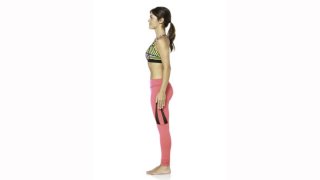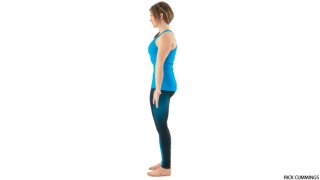
Yoga for Posture Corrections
 Your mom was right: You'll look better and feel great if you stop slouching and stand up straight. Yoga can help you do just that—in a way that honors your spine's natural curves. Here's a guide to assessing and improving your posture.
Your mom was right: You'll look better and feel great if you stop slouching and stand up straight. Yoga can help you do just that—in a way that honors your spine's natural curves. Here's a guide to assessing and improving your posture.
Your mom was right: You'll look better and feel great if you stop slouching and stand up straight. Yoga can help you do just that — in a way that honors your spine's natural curves. Here's a guide to assess and improve your posture.
Are you a slumper? A swayer? Chances are you're one or the other to some degree—despite Mom's best efforts all those years ago to get you to sit up straight and stop slouching. She probably told you that you'd look and feel better if you worked on your posture, and she was absolutely right. But if you're like most people, you rolled your eyes and ignored her, or straightened up until she wasn't looking. And you probably didn't give posture much more thought at all until you walked into your first yoga class and tried to stand in Tadasana (Mountain Pose).
When you're a beginner, it's surprisingly complicated to master the art of rooting down through the feet while lengthening up through the spine, keeping your chest open without jutting your lower ribs out, and keeping the legs muscles strong and lifted without tensing the belly or jaw. But ultimately, Tadasana demands just one simple thing: that you stand in a way that supports the natural curves of a healthy spine. So why is it so difficult? And why do we work so hard to master good posture in yoga—leaving class feeling taller and healthier—only to slump down in the car seat on the way home or revert to a swayback when we heft our overstuffed yoga bags onto our backs?
In short, modern life conspires against good posture. We spend our days sitting at desks, staring at computer screens. When we travel, we do it in cars or—worse—airplanes. We lounge around in overstuffed chairs designed more for looks than for lumbar support. And we pay people to mow our lawns, tend our gardens, and remove our trash so we can spend more time working or driving or sitting. Non-sedentary cultures—with a few exceptions—don't have the same epidemic of back and neck problems that we do. Picture a woman gracefully balancing a large basket of food on her head. To carry such a heavy weight, she must have a perfectly aligned spine and strong posture-support muscles. You don't get that kind of alignment and strength from sitting around and watching the tube. You can, however, get it from a regular yoga practice.
You can, however, get it from a regular yoga practice.
See also Stop Slouching! Improve Posture with Bow Pose
Better Posture Principles: Try this 3-Part Strategy
To create great alignment for your body, I recommend a three-part strategy. First, build awareness by assessing your posture and your lifestyle. Next, create a yoga prescription for your specific postural problem by incorporating a few simple poses into your regular practice. Finally, take your newly developed awareness of your alignment issues and apply it throughout your daily life.
Before tackling the how-tos, however, it's important to understand the anatomy of proper posture. Whether you're sitting or standing, your spine has natural curves that should be maintained. They are a mild forward curve (like a gentle backbend) in the neck and lower back, and a mild backward curve in the upper back and midback. As you practice yoga, you learn to maintain these optimal curves in many standing poses, in most sitting poses, and in inversions like Sirsasana (Headstand) and Adho Mukha Vrksasana (Handstand).
 If any of these curves are habitually flattened or overly curved, abnormal posture can get locked into the body. A wide variety of abnormal curves can occur, including a flat neck and a flat lower back, but we'll focus on the two most common problems: a hunched upper back (known as excessive kyphosis), which is usually linked with a jutting forward of the head (known as forward head) and, at the other end of the spectrum, an extreme sway in the lower back (known as excessive lordosis). These extreme curves contribute to many of the painful problems—muscle strain, joint pain, and disk problems, to name a few—that physical therapists and other health care practitioners treat every day.
If any of these curves are habitually flattened or overly curved, abnormal posture can get locked into the body. A wide variety of abnormal curves can occur, including a flat neck and a flat lower back, but we'll focus on the two most common problems: a hunched upper back (known as excessive kyphosis), which is usually linked with a jutting forward of the head (known as forward head) and, at the other end of the spectrum, an extreme sway in the lower back (known as excessive lordosis). These extreme curves contribute to many of the painful problems—muscle strain, joint pain, and disk problems, to name a few—that physical therapists and other health care practitioners treat every day.
Maintaining just the right curves is only part of the equation, however; to function efficiently, your skeletal structure also needs to be aligned vertically. That means when you're standing, your ears should be over your shoulders, your shoulders over your hips, and your hips over your knees and ankles. When any body part falls out of that vertical line, the adjacent support muscles will feel the strain. For example, years of having a forward head will cause the muscles of the upper back and neck to become tired and achy from holding up the weight of the head against the pull of gravity.
So, while you needn't nag yourself about slouching, you may discover that the simple act of straightening up can change your life. If you train your body to maintain the normal spinal curves and keep your posture vertical and spacious when you're standing or sitting upright, you're likely to feel better all over. And that's something to write home about.
See also Kathryn Budig’s Perfect-Posture Secret: Anti-Slouch Yoga Strap Trick
Do You Slump or Sway? Take the Assessment
The first step toward changing a bad habit is to recognize that you have a problem, right? So, let's start your posture-improvement program by building awareness of your postural pitfalls. You can assess your spinal curves by standing against a doorjamb. When you stand with your heels very near the jamb, you should have contact at your sacrum (the upside-down triangular-shape bone a few inches above your tailbone), the middle and upper back (thoracic spine), and the back of your head. With normal spinal curves, your lower back (lumbar spine) and neck (cervical spine) won't touch—there should be about an inch of space between the doorjamb and the vertebrae of your lower back. But if you can slide your whole hand into the space, you have a swayback, or excessive lordosis.
Standing at the doorjamb also provides valuable feedback about kyphosis and forward head. If you notice that your chin lifts up when you place the back of your head against the jamb, you probably have excessive kyphosis in your thoracic spine. The combination of excessive kyphosis and forward head is common, and it puts significant strain on your neck muscles and intervertebral disks.
It's also worth noting that you could have a combination of postural problems, such as an increased kyphosis with an excessive lordosis. In that case, it's usually best to focus on creating proper alignment in the pelvis and lower back first, and then work your way up the spine.
After your assessment, take a close look at the furniture you use every day at work, home, school—anyplace you spend a significant amount of time. Supportive beds and chairs and a carefully set-up desk and computer workstation will facilitate good alignment. On the other hand, a saggy bed, poorly designed chair, and keyboard at the wrong height will set the stage for degenerating posture. Make the best furniture choices you can to support your journey to better spinal health.









